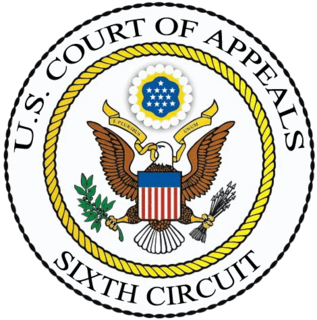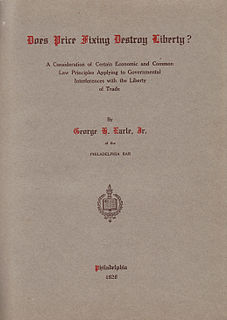In United States patent law, patent misuse is a patent holder's use of a patent to restrain trade beyond enforcing the exclusive rights that a lawfully obtained patent provides. If a court finds that a patent holder committed patent misuse, the court may rule that the patent holder has lost the right to enforce the patent. Patent misuse that restrains economic competition substantially can also violate United States antitrust law.
General Talking Pictures Corp. v. Western Electric Co., 304 U.S. 175 (1938), was a case that the Supreme Court of the United States decided in 1938. The decision upheld so-called field-of-use limitations in patent licenses: it held that the limitations were enforceable in a patent infringement suit in federal court against the licensee and those acting in concert with it—for example, a customer that knowingly buys a patented product from the licensee that is outside the scope of the license.
Quanta Computer, Inc. v. LG Electronics, Inc., 553 U.S. 617 (2008), is a decision of the United States Supreme Court in which the Court reaffirmed the validity of the patent exhaustion doctrine, and in doing so made uncertain the continuing precedential value of a line of decisions in the Federal Circuit that had sought to limit Supreme Court exhaustion doctrine decisions to their facts and to require a so-called "rule of reason" analysis of all post-sale restrictions other than tie-ins and price fixes. In the course of restating the patent exhaustion doctrine, the Court held that the exhaustion doctrine is triggered by, among other things, an authorized sale of a component when the only reasonable and intended use of the component is to practice the patent and the component substantially embodies the patented invention by embodying its essential features. The Court also overturned, in passing, the part of decision below that held that the exhaustion doctrine was limited to product claims and did not apply to method claims.
The exhausted combination doctrine, also referred to as the doctrine of theLincoln Engineeringcase, is the doctrine of U.S. patent law that when an inventor invents a new, unobvious device and seeks to patent not merely the new device but also the combination of the new device with a known, conventional device with which the new device cooperates in the conventional and predictable way in which devices of those types have previously cooperated, the combination is unpatentable as an "exhausted combination" or "old combination". The doctrine is also termed the doctrine of the Lincoln Engineering case because the United States Supreme Court explained the doctrine in its decision in Lincoln Engineering Co. v. Stewart-Warner Corp.
United States v. Univis Lens Co., 316 U.S. 241 (1942), is a decision of the United States Supreme Court explaining the exhaustion doctrine and applying it to find an antitrust violation because Univis's ownership of patents did not exclude its restrictive practices from the antitrust laws. The Univis case stands for the proposition that when an article sold by a patent holder or one whom it has authorized to sell it embodies the essential features of a patented invention, the effect of the sale is to terminate any right of the patent holder under patent law to control the purchaser's further disposition or use of the article itself and of articles into which it is incorporated as a component or precursor.
United States v. General Electric Co., 272 U.S. 476 (1926), is a decision of the United States Supreme Court holding that a patentee who has granted a single license to a competitor to manufacture the patented product may lawfully fix the price at which the licensee may sell the product.
A post-sale restraint, also termed a post-sale restriction, as those terms are used in United States patent law and antitrust law, is a limitation that operates after a sale of goods to a purchaser has occurred and purports to restrain, restrict, or limit the scope of the buyer's freedom to utilize, resell, or otherwise dispose of or take action regarding the sold goods. Such restraints have also been termed "equitable servitudes on chattels".

Fujifilm Corp v. Benun, 605 F.3d 1366 was a case in which the United States Court of Appeals for the Federal Circuit affirmed the judgment made by the United States District Court for the District of New Jersey that the defendants infringed patents owned by Fujifilm Corporation.
Bowman v. Monsanto Co., 569 U.S. 278 (2013), was a United States Supreme Court patent decision in which the Court unanimously affirmed the decision of the Federal Circuit that the patent exhaustion doctrine does not permit a farmer to plant and grow saved, patented seeds without the patent owner's permission. The case arose after Vernon Hugh Bowman, an Indiana farmer, bought transgenic soybean crop seeds from a local grain elevator for his second crop of the season. Monsanto originally sold the seed from which these soybeans were grown to farmers under a limited use license that prohibited the farmer-buyer from using the seeds for more than a single season or from saving any seed produced from the crop for replanting. The farmers sold their soybean crops to the local grain elevator, from which Bowman then bought them. After Bowman replanted the crop seeds for his second harvest, Monsanto filed a lawsuit claiming that he infringed on their patents by replanting soybeans without a license. In response, Bowman argued that Monsanto's claims were barred under the doctrine of patent exhaustion, because all future generations of soybeans were embodied in the first generation that was originally sold.
Adams v. Burke, 84 U.S. 453 (1873), was a United States Supreme Court case in which the Court first elaborated on the exhaustion doctrine. According to that doctrine, a so-called authorized sale of a patented product liberates the product from the patent monopoly. The product becomes the complete property of the purchaser and "passes without the monopoly." The property owner is then free to use or dispose of it as it may choose, free of any control by the patentee. Adams is a widely cited, leading case. A substantially identical doctrine applies in copyright law and is known as the "first sale doctrine".
Henry v. A.B. Dick Co., 224 U.S. 1 (1912), was a 1912 decision of the United States Supreme Court that upheld patent licensing restrictions such as tie-ins on the basis of the so-called inherency doctrine—the theory that it was the inherent right of a patent owner, because he could lawfully refuse to license his patent at all, to exercise the "lesser" right to license it on any terms and conditions he chose. In 1917, the Supreme Court overruled the A.B. Dick case in Motion Picture Patents Co. v. Universal Film Mfg. Co.,

The Button-Fastener Case, Heaton-Peninsular Button-Fastener Co. v. Eureka Specialty Co., also known as the Peninsular Button-Fastener Case, was for a time a highly influential decision of the United States Court of Appeals for the Sixth Circuit. Many courts of appeals, and the United States Supreme Court in the A.B. Dick case adopted its "inherency doctrine"—"the argument that, since the patentee may withhold his patent altogether from public use, he must logically and necessarily be permitted to impose any conditions which he chooses upon any use which he may allow of it." In 1917, however, the Supreme Court expressly overruled the Button-Fastener Case and the A.B. Dick case, in the Motion Picture Patents case.
Impression Products, Inc. v. Lexmark International, Inc., 581 U.S. ___ (2017), is a decision of the Supreme Court of the United States on the exhaustion doctrine in patent law in which the Court held that after the sale of a patented item, the patent holder cannot sue for patent infringement relating to further use of that item, even when in violation of a contract with a customer or imported from outside the United States. The case concerned a patent infringement lawsuit brought by Lexmark against Impression Products, Inc., which bought used ink cartridges, refilled them, replaced a microchip on the cartridge to circumvent a digital rights management scheme, and then resold them. Lexmark argued that as they own several patents related to the ink cartridges, Impression Products was violating their patent rights. The U.S. Supreme Court, reversing a 2016 decision of the Federal Circuit, held that the exhaustion doctrine prevented Lexmark's patent infringement lawsuit, although Lexmark could enforce restrictions on use or resale of its contracts with direct purchasers under regular contract law. Besides printer and ink manufacturers, the decision of the case could affect the markets of high tech consumer goods and prescription drugs.
Leitch Manufacturing Co. v. Barber Co., 302 U.S. 458 (1938), is a 1938 decision of the United States Supreme Court extending the tie-in patent misuse doctrine to cases in which the patentee does not use an explicit tie-in license but instead relies on grants of implied licenses to only those who buy a necessary supply from it.

National Lockwasher Co. v. George K. Garrett Co., 137 F.2d 255, is one of the earliest or the earliest federal court decision to hold that it is patent misuse for a patentee to require licensees not to use a competitive technology. Such provisions are known as "tie-outs."
The reverse doctrine of equivalents is a legal doctrine of United States patent law, according to which a device that appears to literally infringe a patent claim, by including elements or limitations that correspond to each element or limitation of the patent claim, nonetheless does not infringe the patent, because the accused device operates on a different principle. That is, "it performs the same or a similar function in a substantially different way." It has been said that "the purpose of the ‘reverse’ doctrine is to prevent unwarranted extension of the claims beyond a fair scope of the patentee’s invention."
Rubber Co. v. Goodyear, 76 U.S. 788 (1869), is an early decision of the United States Supreme Court recognizing the right of a patent owner to license another person to practice the invention only in a limited field, and holding that such a licensee committed patent infringement when it made and sold products of the invention outside that field.





